Iberian Chiffchaff Phylloscopus
ibericus, Brownstown Head, Co Waterford, 16 June 2010: new to Ireland
PM Walsh Last updated 27/06/2010
The bird was found just after 1.30 pm in the main willow-garden on the head, during
warm, sunny conditions with light NE winds. It first attracted attention by its distinctive three-phase (or
four-phase) song - very roughly, 'chiff - chiff - chiff - wee - wee - wee - ch-ch-ch' or 'tiff - ...', the final part being
a fast "chatter". A brief snatch of Chiffchaff-type song had been heard in early morning (then no coverage until 1.30),
so in this context, and based on partial recall of online songs heard previously, I immediately thought of Iberian
Chiffchaff. The song was initially heard 7 or 8 times. When I approached more closely, I saw a phyllosc (in
shade) in some medium-tall willows, and it called 'tew' or 'psew' or 'teeuu' a few times - a down-slurred / down-inflected
call that, again, sounded like what I remembered of Iberian Chiffchaff calls online. The bird may have moved away slightly,
and I "pished" a few times, which may have stimulated further calling (calling continued for a minute or more). Some
poor recordings of the song and call were taken using an iPhone, then a couple of reference recordings (BWPi and Roche's CD
of European bird sounds) were checked to confirm ID before phoning out the news just before 2 p.m.
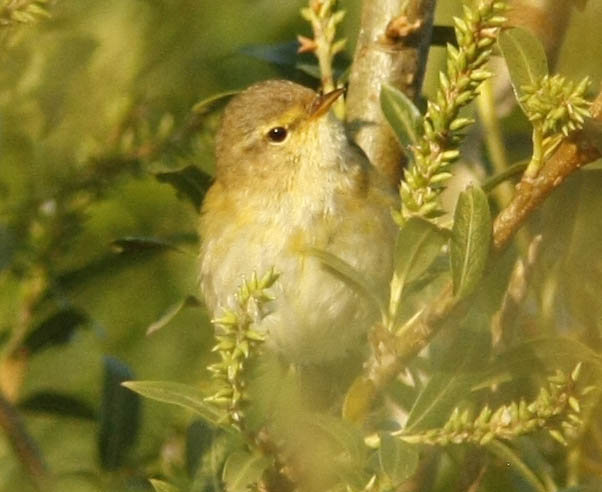
|
| Iberian Chiffchaff, Brownstown Head, 16 June 2010 © M O'Keeffe |
Twenty or more birders arrived at various points through the afternoon and early
evening, and the bird sang quite well early on then quietened down a bit before resuming again in early evening. Clear
(or any!) views were hard to come by, however, but most people did get reasonable but brief views in the end, and
occasional good telescope views. Song was mostly full 3-phase or 4-phase song (see sonograms below), mostly with the
final "chatter". For much shorter periods, 2 or 3 times in the afternoon, a Common Chiffchaff-like song was heard
over several minutes, including c2.20 p.m. and c4 p.m. A song phrase which appeared to be a mix of Common
(at the start) and Iberian (at the end) - e.g. 'chiff - chaff - chiff - chaff - ch-ch-ch' - was heard a few times after
the first or second bout of Common Chiff-type song. Thereafter, song was either "full" Iberian (e.g. for a full hour
c2.30-3.30 p.m.) or, in mid/late afternoon as bird appeared to quieten down, occasionally a subsong-like sequence of
'chiff - chiff - chiff...'-like notes apparently the same as first phase of full song. This was mainly heard c4.10 p.m.,
with also some Common Chiffchaff-type subsong around the same time. In full song, ' the 'wee - wee' notes had
some similarity to part of Meadow Pipit song, while the final chatter was reminiscent of the terminal chatter of a Reed Bunting
song. The 'tew'/'psew' call was not heard anytime after 2 p.m., as far as I'm aware.
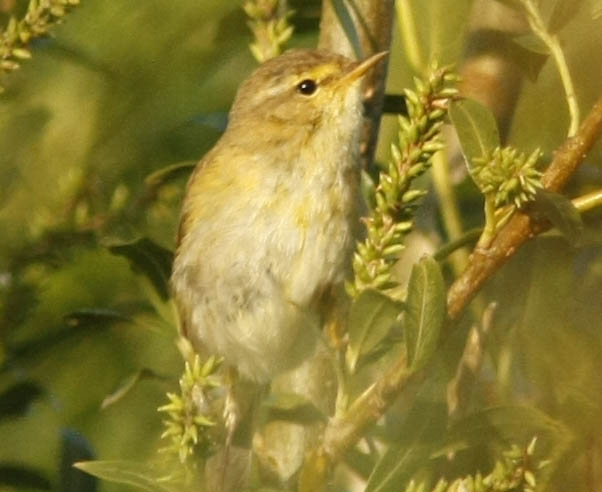
Views of the bird itself indicated a fairly clean-looking phyllosc, with medium-olive upperparts,
off-white underparts, some pale yellow on the lower ear coverts/chin and breast-sides by bend of wing; and from photos also
(a bit messily) on lower/mid breast and apparently on vent. The head pattern looked more strking than a typical Chiffchaff;
the pale supercilium and dark eyestripe were quite long, extending well back behind eye, more closely resembling a Willow
Warbler. (A Willow Warbler did cause some confusion initially, feeding close to where the Iberian Chiff was singing,
but was even 'cleaner' and had more obviously pale legs.) The supercilium was obviously yellow immediately
in front of the eye, whiter behind the eye. The eyering was less contrasty than on typical Chiffchaff, with the
lower part of the eyering less markedly paler/whiter compared with upper part though photos suggest it may have
been slightly whiter below. On upperparts, there was an impression of a pale 'panel' on the folded wing, which in one
of the photos appears to involve mainly the outer edges/fringes of the tertials.
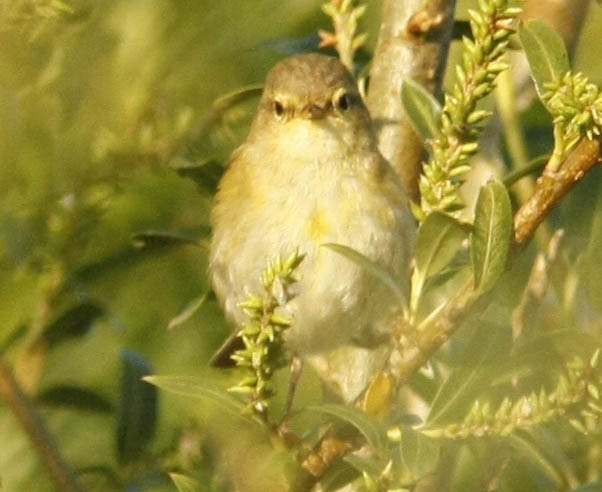
The bill was fine and from the side looked mainly pale or medium-pale, i.e. apparently most
of lower mandible plus cutting edges of upper mandible (photos also suggest a pale extreme tip). This occasionally
contributed a slightly long-billed impression. Leg colour appeared mainly dark (or in shadow) in the one telescope view
I had, but feet and lower part of tarsus ("boots") appeared pale-to-mid brown, probably not as pale as on Willow Warbler. The
"boots" impression was perhaps partly an artefact of shadow - whole tarsus may have been medium-brown, and photos
seem to show this, but confirmation ideally needed from other observers.
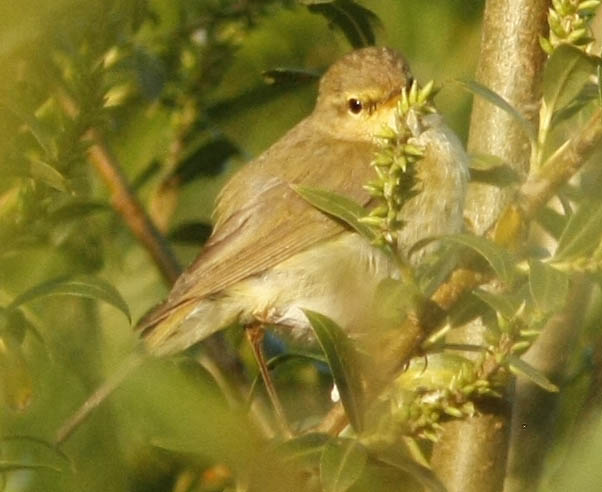
Structurally, beyond it being a typical small phyllosc (I'd have to leave finer distinctions
to others!), the main feature of interest was the primary projection. In general terms this looked pretty
short, i.e. broadly similar to Common Chiffchaff at roughly half the length of the exposed tertials, but any finer distinctions
were tricky to make. (Further checking of photographs may help - more examples below - though difficult to
interpret as definition of tip and especially visible base of tertials are not clear-cut, in part because of messy scapulars.)
It regularly pumped or flicked its tail, but any distinctions from similar behaviour of Common Chiffchaff I'd have to leave
to others.
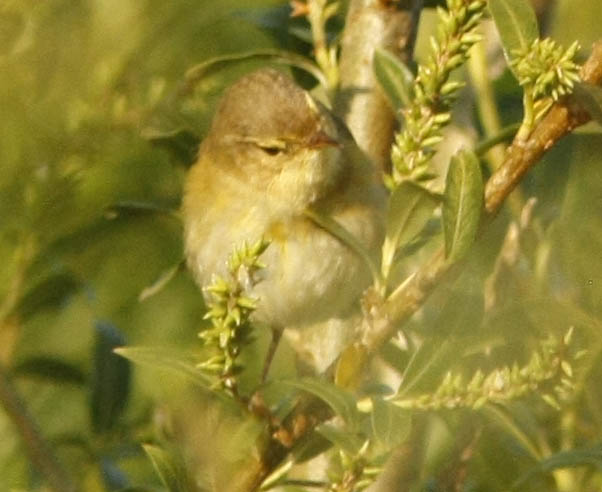
No warblers had been seen or heard during the the previous three days, when I was in the
garden for several hours each afternoon in similar sunny weather. This
suggests it had arrived on 16th June, though habitat elsewhere on the headland had not been checked. There was no sign
of it the following morning (17th June), when the garden was checked from at least 6 to 10 a.m. A well-fledged juvenile
Chiffchaff was present on 19th & 20th June, superficially similar in some respects (but with a more obvious Common Chiff-type
eyering among other differences), plus an unidentified silent phyllosc on 19th (possibly the Willow Warbler from 16th).
A selection of sound-files and sonograms is given below (thanks to Mike O'Keeffe &
Martin Garner, and Mike for the photos too), and click here to listen to song on a YouTube video clip (Paul Moore).
For online recordings of Iberian Chiffchaff song or call, see (among others):
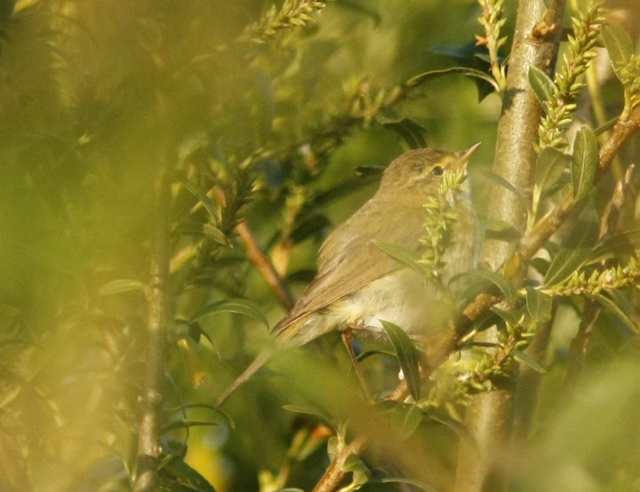
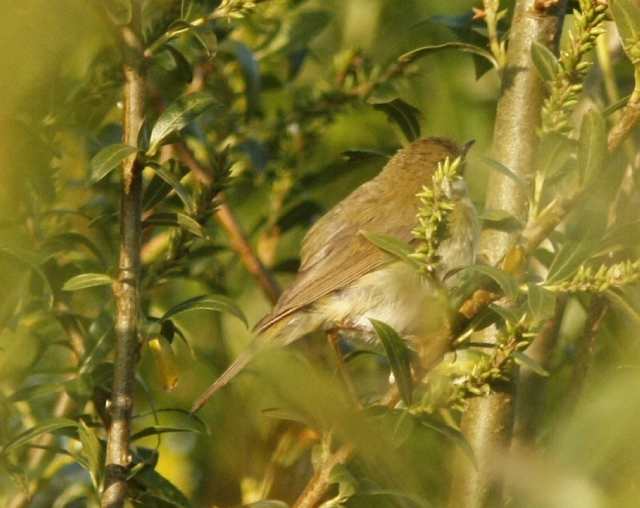
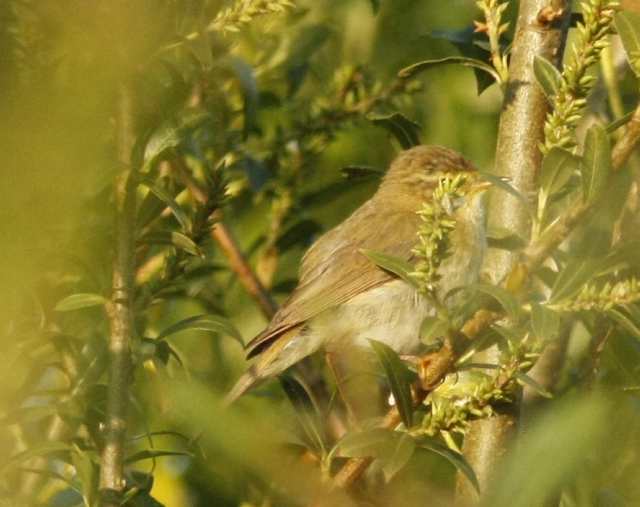
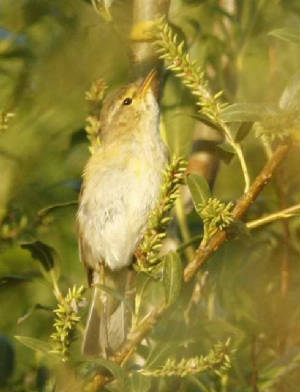
|

